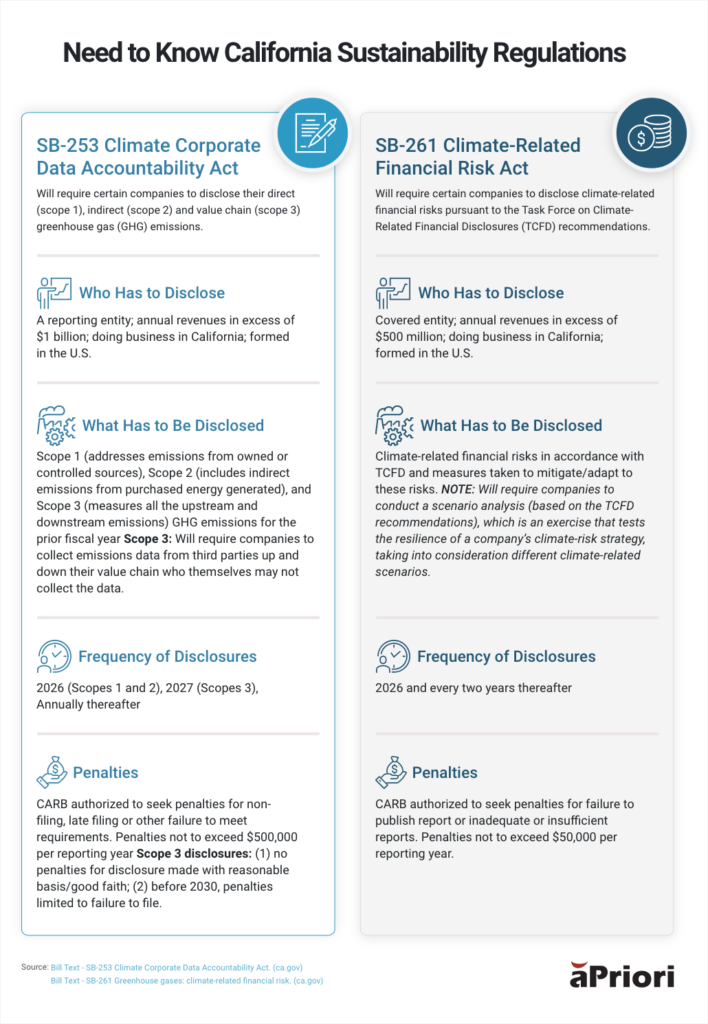
Key Takeaways:
- Manufacturers in California face impending sustainability regulations that can significantly impact operations
- aPriori can help manufacturers navigate and meet these regulations in their quest to become green businesses
The Full Article:
California’s new sustainability mandates will require manufacturers—even privately-owned companies—to change their approach to sustainability. These new mandates follow environmental, social, and governance (ESG) regulations in the European Union and the Securities and Exchange Commission’s proposed climate-related disclosure requirements. Here’s what you need to know.
If you do business in California and have revenues above the relevant threshold, you will be subject to these requirements, regardless of where your operations are located, or the revenues generated.
What is Sustainable Manufacturing and Why Does It Matter?
Sustainable manufacturing is the process of designing and making green products with materials and processes that minimize their environmental impact. All economic and environmental aspects of the product’s lifecycle, from design to disposal or reuse, are considered.
Traditional manufacturing methods and materials often produce lead to greenhouse gas (GHG) emissions. Consumers, governments, and investors demand more green business and sustainable brands. They also seek greater corporate, environmental, and social responsibility. Governments are implementing more stringent environmental policies and imposing hefty penalties for non-compliance. Legal entities are bringing cases against non-compliant business owners.
It is imperative that manufacturers understand the sustainability mandates that apply to them and, more importantly, what they can do to implement sustainability initiatives, reduce their carbon footprint, become more transparent in their sustainability goals and progress, and ensure that they can meet and adequately report the requirements outlined in these mandates. For more information on sustainable manufacturing, read our guide.
In this short video, hear how Carrier is paving the way to massive carbon reduction with aPriori.
Time is of the Essence: California Sustainability Regulations for Green Business
Several California sustainability regulations will be enforced in 2026. Rather than wait until then, it is time to prepare for these mandates now.
To help meet the United Nation’s (UN) goal to reduce global carbon emissions, the European Union has implemented the following:
· The European Union’s (EU) “Carbon Tariff
· EU Taxonomy Sustainability Reporting Requirements
California Governor Gavin Newsom signed two new bills into law on October 7, 2023. Many large U.S. companies will be required to make broad-based, climate-related disclosures as early as 2026. These laws will have a profound impact on companies with business operations in California. Certain disclosure requirements go beyond those in the SEC’s proposed climate-related disclosure rule or the current practices of most public companies.
How These Bills Impact Manufacturers
These bills are not comprehensive. Additional amendments and regulation implementation could change their current scope. Moreover, many organizations may already be subject to other regulations like those imposed by the European Union. The nuances between California’s and the European Union’s regulations further add to the confusion and additional resource requirements.
For example, any company that “does business” in California with revenues above the relevant threshold is subject to these requirements, regardless of where its operations are located, or the revenues generated. Likely more than 5,000-10,000 organizations, many privately held, will fall under SB 253 and SB 261 regulations, respectively. However, most likely have not assessed the full scope of their GHG emissions or implemented the TCFD recommendations. For a more detailed look at the potential impacts of these bills, read this Harvard Law School Forum on Corporate Governance article.
Scope 3: aPriori’s Sustainability Sweet Spot
The new California laws require manufacturers to provide emissions across their supply chains – including that of their suppliers. Here’s how we can help.
According to the UN Global Impact Network UK, Scope 3 includes all indirect emissions (not in Scope 2), including both upstream and downstream, that occur in the reporting company’s value chain. Since these usually account for over 70% of a business’s carbon footprint, companies must address them to meet consumer, stakeholder, and legislative expectations. Doing so can help them:
- Determine emission hotspots in their value chain
- Pinpoint their supply chain material waste and energy overuse
- Discern suppliers’ sustainability performance
- Find value chain energy efficiency and cost reduction opportunities
A small supplier for a manufacturer might not have the means to determine how much energy is used to make a component. However, aPriori can create a digital factory of that small supplier’s production facility (machines, energy supplies, materials) to determine its carbon footprint. This data is critical to ensuring transparency and traceability in reporting and understanding how it will impact your supply chain.
Watch this video to see how Scania accelerated its CO2e calculations with aPriori.
aPriori’s 4 Stages for a Green Business
aPriori’s four-stage sustainability maturity model integrates traceable green practices into manufacturing while balancing profitability and environmental impact. This framework guides manufacturers toward environmental stewardship using data-driven insights to make effective design, sourcing, and production choices. Equally important, it provides them with transparent and auditable reporting to meet compliance standards.
Stage 1: Create Precise, Auditable CO2e Emissions Baselines. Such a baseline ensures a green business since a manufacturer’s existing supply chain’s carbon footprint can be measured and quantified. The manufacturer can identify the highest carbon and cost reductions, set realistic cost targets to drive a product’s supply chain decisions, meet ESG standards and regulations, and measure sustainability performance against competitors. Although life cycle assessment (LCA) systems can analyze a product’s complete carbon footprint, they cannot provide real-time CO2e data in the early stages of product development when decisions have the greatest impact.
Stage 2: Select Sustainable Global Suppliers. Supply chains can account for more than 80% of a typical manufacturer’s GHG. Knowing a supplier’s sustainability performance is not enough. You also need to understand their local electricity mix, material supplies, and processes (all of which fall under Scope 3). aPriori provides full sustainability visibility into those supply chains. Manufacturers can run “what-if” scenarios (routings, materials, volumes, regions). Digitally connected buyers and suppliers reduce iterations and delays and ensure more sustainable procurement strategies that meet internal ESG goals.
Stage 3: Optimize Existing Products for Cost and Carbon. aPriori empowers manufacturers to consider alternative materials that are more recyclable and eco-friendly. It can simulate production based on a product’s geometry, manufacturing overhead costs, direct labor and machine hours, etc. Additionally, processes can be evaluated for renewable energy efficiency. Cost vs. carbon can be calculated and analyzed for reduction opportunities early in the product design process, informing faster and better decision-making.
Stage 4: Remove Embodied CO2e Through Data-driven Product Design. A product’s early design determines 80% of its environmental impact throughout the lifecycle. It is here where manufacturers can make the largest inroads into becoming green businesses. Real-time CO2e feedback from the 3D CAD model enables design engineers to proactively modify the product’s design to reduce its embodied carbon.
Learn more about aPriori’s four-stage sustainability maturity model.
Become a Lean, Green Business with aPriori
As the effects of climate change continue to increase, sustainable manufacturing becomes more urgent. The sooner manufacturers commit to sustainable practices to impact climate action, the faster they will lower their carbon footprint.
They’ll be able to do more with less (greater efficiencies, less energy/material waste). Their operations will be greener (eco-friendly products), and they will be flush with green notes (improved bottom line).
Can You Do More with Design and Production?
Yes. You can. See how both impact cost, sustainability, and performance…in real-time…with aPriori






